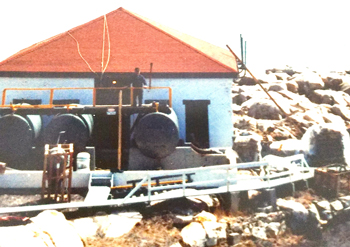Civilian Workers, USCG Station Southwest Harbor
by Lee S. Wilbur

“First day working out on “The Rock” (Mt. Desert Rock located some 20 miles off the coast of Maine) I had half the floor I was working on done by evening. Finished everything I had to do the second day and then I was stuck out there for 15 days. It was never my favorite place. Wind and seas were so high they couldn’t land a boat to pick me up.” — Jack Gilley, Carpenter Civilian worker, US Coast Guard, telling of his several years experience repairing and maintaining lighthouses and navigational buoys as a civilian worker for the US Coast Guard.
Boston Light, established in 1716 on Little Brewster Island, was the first recorded lighthouse in North America. However, it was not until 1789 when our first elected Congress passed an “Act for the establishment and support of light-houses, beacons, buoys, and public piers” placing their responsibility and upkeep under the Dept. of Treasury. By 1801, after a rather haphazard system of funding which included fees levied on ship traffic, the United States Congress began funding aids to navigation. Even then, not until 1848 was a standardization for shapes, sizes and colors established. This lack of standardization caused many problems for coastal pilots who had complained bitterly that the buoys were so small that to see them they had to almost run them down.
Many years later, the U.S. Coast Guard decided they were ultimately responsible for the placing and upkeep of navigational aids. They then decided for several reasons the repairs and upkeep would be more efficient with cost savings and higher quality if placed under a civilian crew on Government payroll and scale. Idea being twofold: the civilian crews having longevity would necessarily need to be trained just once and would understand the methods needed for maintenance. Time and money in not having to retrain a fresh crew every few years would be a major time and effort saving. The employees in turn would be encouraged to make this a career which included Government benefits.

Mount Desert Rock Lighthouse. The Lighthouses had 3,000 gallon tanks for the generators which were filled by Coast Guard ships.
As Jack tells his story of signing on as a civilian worker: “In 1956, my good friend Linwood Ginn called and said there was an opening in the civilian buoy tending crew there in Southwest Harbor and thought I might want to apply. I had told him to make sure if an opening should come up I’d be interested and to call me immediately. Work in Southwest Harbor at that time was hard to come by. Several of the older crew, a few in their 70s, were starting to retire and there would be more positions opening up in the next few years. I immediately hung up the phone and drove around the harbor to the base. Carlton Hill, Superintendent of civilian workers interviewed me. My qualifications as carpenter and painter were such that I was offered a position immediately.” (At this time, when the men had to work overnight or away from home they were paid $4.00 per diem with $2 per diem subtracted for meals.)
Warrant Officer W/4 George Hupper was Station Commander for USCG BASE: SOUTHWEST HARBOR at the time, and Carlton Hill was the civilian crew boss in charge of maintenance for the lighthouses and other aids to navigation.”
Bear Island, at the entrance to Northeast Harbor, the facility for maintaining the Aids had been shut down and all maintenance operations had been moved to the newly refinished Southwest Harbor Base station. Base Southwest Harbor would prove to be a more ideal site for not only Coast Guard operations, with the ability to berth more and larger vessels, but for the handling of the larger offshore spar and bell buoys as well.
“I remember,” says George Jellison, hired in 1956 as a civilian electrician, “that when I first came to work we were just beginning to replace the old diesel generators from World War II as well as many of the wooden sheds which were in pretty hard shape. The sheds were torn down and replaced with moulded fiberglass sheds which would handle harsh weather better than the wood. The Lighthouses would have 3,000 gallon tanks which were filled by Coast Guard ships. One of the generators would be dedicated just for the radios or for communications. We would do what was known as “Top Down” maintenance on one of the three generators each year. There would be three set up side by side. An outer one would be taken out for service and a new one moved in to it’s place. Next year the one beside would come out for service the previously serviced would be moved over and a new or serviced one take it’s place. Seemed like a lot of extra work when we could have just tagged the next one to be serviced.”
At about this same time, the Coast Guard made the decision to begin servicing the lighthouses by helicopter. However, in order to do this Heli-pads had to be constructed. The first was attempted by drilling into the rock surface on Mt Desert Rock. However, the going was hard and promised to be quite time consuming, so the decision was made to use pressure treated lumber known then as “Green Heart” for construction. Being extremely heavy, a standard helicopter in Coast Guard service could not handle the weight of these timbers. One barge while trying to unload lost the entire cargo, which immediately sank. Finally, one of the men had the idea to contact the Naval Reserve and ask them to bring one or two “Skytrain” helicopters up from Boston to carry the timbers out. This worked well, having the helicopters stationed at Bar harbor Airport while work went on. (To be continued.)
Fair Winds and Good Fishing
– Lee Wilbur
